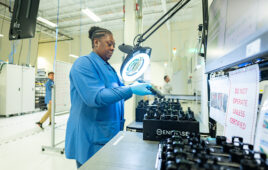By Katie Ryan, director of partnerships of WattTime; and Peter Bronski, founder and CEO of Inflection Point Agency
In early August, SolarEdge’s Lior Handelsman penned a Solar Power World article “Smart Inverters Are Key to Building a Flexible Grid Solution.” Roughly two-thirds of the way through the article came this passage:
“Just as machine learning, partial autonomy and artificial intelligence are becoming a larger part of our everyday lives, so too should they be integrated into energy control platforms. Advanced analytics and machine learning can help plan for more flexibility and increase predictability to enable PV generation and load forecasting. In addition, there are certain types of events that need a fast frequency response and require local autonomy or grid-edge computing. When controlled by platforms with partial autonomy, our grid can become increasingly efficient, flexible and smart.”
Indeed, flexibility—in part through machine learning, AI, automation, etc.—will be increasingly important. But the bigger opportunity goes far beyond predicting PV generation and forecasting load. With smarter demand-side solutions, we’ll see a shift from load forecasting to load flexibility. We’ll be able to go from solar predictability (know what’s coming) to proactive solar consumption (use what’s coming). And in the biggest picture, we’ll go from a legacy perspective of ‘dynamic supply meets forecasted but static demand’ to ‘smarter and flexible demand dictates and uses cleaner, renewable generated supply.’
It’s not merely that a high-renewables grid needs inherent flexibility, but also that such flexibility unlocks new potential that wasn’t possible before. This presents tremendous opportunity, especially in the years ahead as states continue their march toward renewables targets and the grid integrates greater mixes of solar (and wind, batteries, etc.) alongside some legacy coal and many natural gas plants.
There are at least five important reasons why flexibility matters to the solar business:
1. Emissions reductions: From New York to California, the minute-to-minute and hour-to-hour variations in real-time grid emissions is becoming much greater, as states’ electricity generation mixes become a blend of polluting fossil-fueled plants and clean generation solar and other renewables. Armed with a software signal based upon real-time, location-based marginal emissions data—which WattTime calls Automated Emissions Reduction—flexible demand can shift around energy consumption to use more clean energy and avoid more dirty energy. This can slice off a big chunk of marginal emissions.
2. Curtailment: To co-opt a popular, decades-old slogan, “Renewable energy is a terrible thing to waste.” Yet that’s exactly what happens with curtailment, when there’s insufficient grid demand to absorb renewable energy and that clean energy unfortunately gets wasted. A flexible grid—anchored by flexible demand—can shift consumption to moments of surplus solar to put that low-cost clean energy to good use.
3. Cost: A future grid with high-percentage renewables and no flexibility would potentially be a more-expensive grid, despite the ongoing price declines for solar and wind. That’s because without flexibility, grid planners would need to build excess renewable generation, basically accepting renewable energy curtailment at surplus times in order to avoid undersupply at other times. Demand-side flexibility can reduce such a need to overbuild, since demand can be better “pushed around” to align with renewables’ predictable-but-variable generation patterns.
4. Solar+storage: There’s a persistent idea that energy storage both provides needed flexibility in a renewables-rich grid and reduces emissions through integration and consumption of more solar-generated electricity. But flexible demand—such as that using a signal like Automated Emissions Reduction—can provide many of the same services as storage but at a fraction of the cost, and storage often increases emissions but doesn’t have to. (In fact, the California PUC recently released its staff recommendation for how to incorporate a real-time GHG signal into energy storage charging and discharging in order to help “get the emissions out.”)
5. Distributed energy resources (DERs): As customers adopt more DERs—from smart thermostats to electric vehicles—those assets can both provide flexibility and tap into flexibility for a dynamic, high-renewables future electricity grid. The idea of rooftop solar customers self-consuming more of the electricity they generate, or of utility-scale solar getting “credit” for its contribution to peak, both take on new meaning when the demand side is informed by better intelligence that tells DERs when it’s better to use or not use grid-based electricity.
 A flexible future grid needs better signals to guide that flexibility. One such signal could be WattTime’s Automated Emissions Reduction. We’ve seen its potential, and analyzed its opportunity if adopted as mass scale. The size of the prize is large, and all corners of the solar market have a stake in seeing AER-like software signals succeed as we together champion a reliable, low-cost, clean electricity grid.
A flexible future grid needs better signals to guide that flexibility. One such signal could be WattTime’s Automated Emissions Reduction. We’ve seen its potential, and analyzed its opportunity if adopted as mass scale. The size of the prize is large, and all corners of the solar market have a stake in seeing AER-like software signals succeed as we together champion a reliable, low-cost, clean electricity grid.
So what can the solar industry do about flexibility? For starters, we can move beyond treating solar-generated electricity as the static, passive recipient of needed flexibility for the sake of solar’s grid integration. Instead, we can think of solar paired with intelligent demand-side flexibility as an active capability that enhances solar’s grid value. Next—and as the California PUC has started to do with its energy market—we can open conversations with state regulators and others about what it means to pair solar with a capability like Automated Emissions Reduction. If we succeed in doing that, we potentially open up new value streams that help to usher in solar’s next great evolution.





Tell Us What You Think!